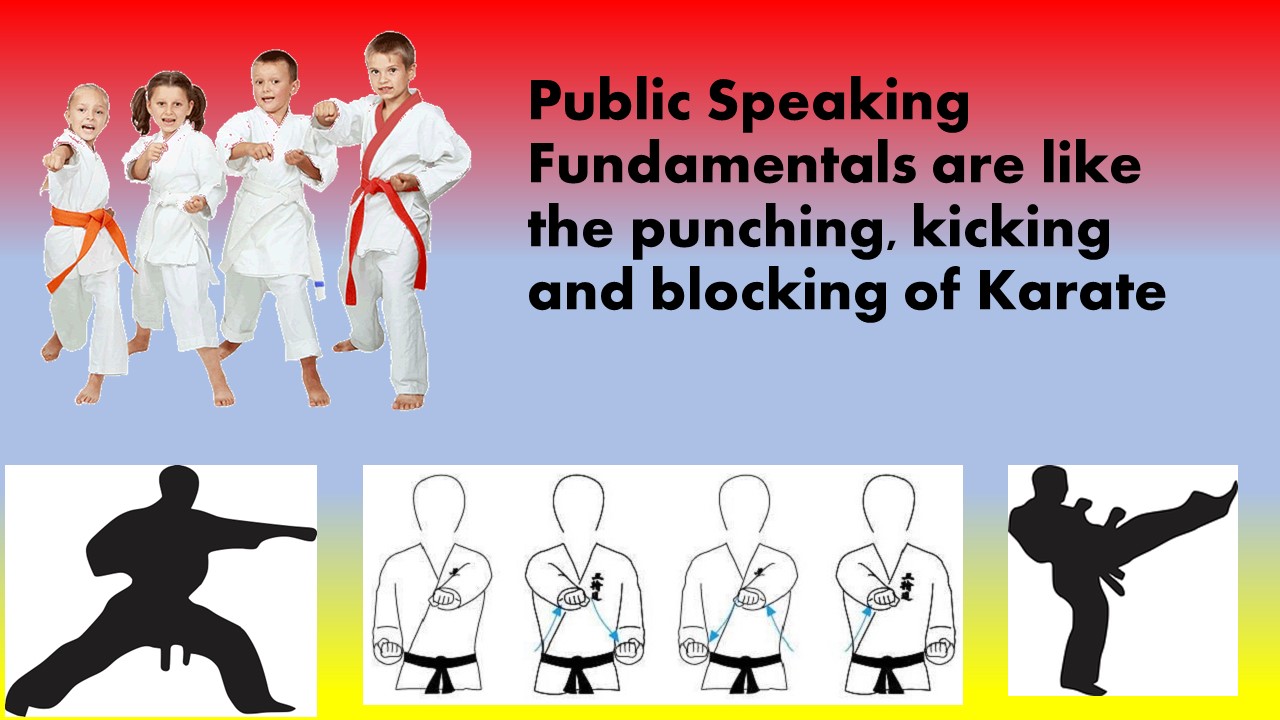Public Speaking Fundamentals: Back to Speaking Basics
There are at least two opportune times to study the fundamentals of public speaking.
- When you are a novice.
- When you have been doing it so long that you forgot or ignore the fundamentals.
The first case might be obvious. The second case might not be as clear and that’s why you might need to think about it. Even if you believe you are an expert, you still need to revisit the fundamentals from time to time.
Here’s a vivid illustration of re-examining the fundamentals.
When I was a Karate student we learned and practiced two activities – sparring and kata. I had a love-hate relationship with both. Sparring was another word for fight. This was the most exciting activity for me. This is why I joined the Karate club, to learn how to fight. Sparring was the expression and testing of that training. The downside was the painful bruises I gained even with the padding.
Kata was the performance of routines and patterns. To an outsider it might have looked like a dance. It was how we built muscle memory for the blocks, kicks and punches. Practicing kata could be boring, like practising any exercises. Imagine practising scales on the piano – boring and necessary to build the patterns.
Even though kata could be boring, it was also wonderful when you performed the moves well because you knew that practise was working for you. The bonus was you avoided bruises.
As you might guess Kata increased in difficulty and complexity as one progressed up through the grading of belt levels from white to black belt. Many of us were eager to discard the simple katas and move on to the more complex routines.
Imagine my surprise when I attended tournament where a black belt performed the first kata that white belts learned. Usually, black belts dazzled us by preforming the most complex and elaborate moves.
This beginners’ kata contained the most fundamental moves that we learned. They were simple and powerful blocks, kicks and punches that won most fights. This black belt demonstrated and explained the purpose and power of each movement in slow motion. It was beautiful to watch. Simplicity and effectiveness in action.
I was entranced by that demonstration and returned to practising the fundamentals that I had assumed were beneath me because at that time I was an orange belt.
Curious how quickly we might become arrogant and forget to practise the fundamentals.
As a public speaker or business presenter it might be time for you to revisit the fundamentals of effective presentations.
What are those fundamentals of public speaking?
- Speak louder
- Speak slower
- Pause more often
Let’s review each of these points.
Speaker Louder
This might seem like a silly point, yet many speakers don’t speak up to be heard. Whether you are speaking in board room, networking meeting, job interview or conference center – if the audience can’t hear you – it was a failed presentation. Some of you need to speak louder – loud enough for the audience to hear every word you say.
I’ve run into a few people who speak too loud and that’s unusual. I’ve attended conferences where the speaker was too loud and that was a microphone problem. The speaker didn’t know how to use the microphone or the AV people were asleep.
Those were exceptions. It’s more common for the speaker to speak so softly that the audience didn’t hear them.
When you have a message worth spreading – speak up! Speak loud enough to be clearly heard by everyone in the room. Always speak to the person who is farthest away from you. Project your voice.
Speaking louder has nothing to do with how big or small you are. People have told me “I’m a small person, I can’t speak louder.”
Nonsense! A tiny baby can scream your ears off. Why” Because they breathe by filling their lungs from the bottom of diaphragm. That’s what it takes to speak louder – more air in your lungs. Practice breathing deeply before you speak to remind yourself to breathe fully. Project by speaking to the person who is farthest away from you.
You might feel uncomfortable when you start speaking louder because it will feel strange to you. That’s normal. You’ll get used to it just as you got used to speaking quietly.
Speak Slower
Many speakers need to slow down when presenting. It’s one thing to speak rapid-fire with friends or when in a fast-paced discussion. Rapid-fire speaking is a problem when delivering a presentation because people need enough time to hear your words, process the meaning and think about the concepts.
It’s especially important to speak slower when there is a crisis because you want to appear calm, confident and clear on next steps.
You need to speak slower when presenting new ideas, a major change or when selling products or services. Speaking too quickly might appear as shifty, anxiety or pushy.
When you speak quickly, your voice tends to be higher pitched, squeaky and maybe annoying. Speaking slower allows your voice to sound deeper and hence more pleasant, calm and believable.
When you speak slower, you are more likely to choose your words more purposely and hence sound more intelligent, mature and competent.
Slow down when you speak.
Pause More Often
Some speakers fear silence. They are afraid to pause and allow quiet space during their presentation because they believe the silence is a sign of weakness. They believe that they should keep speaking, speaking, speaking – even if they are spewing nonsense.
Instead, see the pause as a sign of strength, confidence and control. It can be difficult to pause when you speak, yet it is a powerful technique. Like every other aspect of presenting, you need to practice to become comfortable and more effective.
Your first pauses might only be one or two seconds, yet to you they will feel painfully long. Keep working at it and eventually you can become adept and comfortable with pauses of five seconds or more when appropriate.
A pause grants your listeners time to think about what you said. It also builds the anticipation for the next part of the message. Notice the effect of the pause at the Academy Award when they say. “May I have the envelope please.”
Pausing conveys the impression that you are confident with your message, that you are willing to allow your audience time to think about your words and that you respect them.
The pause demonstrates that you are not afraid of silence, questions or a challenge. Pausing allows the audience their thinking space instead of flooding them with the constant noise of your flapping lips.
Is this a good time for you to examine these fundamentals of public speaking?
If you are a novice speaker, of course you start with the fundamentals and work on those initial blocks, kicks and punches.
If you consider yourself a black belt of speaking, you need to return to the fundamentals to strengthen your technique.
If you are somewhere in between, it’s also relevant to review the fundamentals on a regular basis because smart habits build success.
The fundamentals are simple, powerful and there are no bruises.

